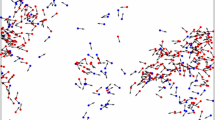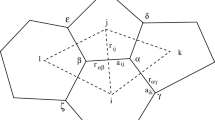Abstract
This paper deals with the derivation of a collective model of cell populations out of an individual-based description of the underlying physical particle system. By looking at the spatial distribution of cells in terms of time-evolving measures, rather than at individual cell paths, we obtain an ensemble representation stemming from the phenomenological behavior of the single component cells. In particular, as a key advantage of our approach, the scale of representation of the system, i.e., microscopic/discrete vs. macroscopic/continuous, can be chosen a posteriori according only to the spatial structure given to the aforesaid measures. The paper focuses in particular on the use of different scales based on the specific functions performed by cells. A two-population hybrid system is considered, where cells with a specialized/differentiated phenotype are treated as a discrete population of point masses while unspecialized/undifferentiated cell aggregates are represented by a continuous approximation. Numerical simulations and analytical investigations emphasize the role of some biologically relevant parameters in determining the specific evolution of such a hybrid cell system.






Similar content being viewed by others
Notes
Throughout the paper we will use the subindex \(t\) to denote dependence on time of measures or measure-related quantities. In no case will this notation stand for the time derivative, which will be indicated by an explicit symbol such as e.g., \(\partial _t\).
Recall that, by definition, population \(2\) has the same initial condition in both cases.
References
Ambrosio L, Gigli N, Savaré G (2008) Gradient flows in metric spaces and in the space of probability measures. Lectures in mathematics ETH Zürich, 2nd edn. Birkhäuser, Basel
Anderson ARA, Chaplain MAJ (1998) Continuous and discrete mathematical models of tumor-induced angiogenesis. Bull Math Biol 60(5):857–899
Anderson ARA, Chaplain MAJ, Rejniak KA (eds) (2007) Single-cell-based models in biology and medicine. Birkäuser, Basel
Anderson ARA, Weaver AM, Cummings PT, Quaranta V (2006) Tumor morphology and phenotypic evolution driven by selective pressure from the microenvironment. Cell 127(5):905–915
Capasso V, Morale D (2009) Asymptotic behavior of a system of stochastic particles subject to nonlocal interactions. Stoch Anal Appl 27(3):574–603
Capasso V, Morale D (2009) Stochastic modelling of tumour-induced angiogenesis. J Math Biol 58(1–2):219–233
Carrillo JA, Fornasier M, Toscani G, Vecil F (2010) Particle, kinetic, and hydrodynamic models of swarming. In: Naldi G, Pareschi L, Toscani G (eds) Mathematical modeling of collective behavior in socio-economic and life sciences, modeling and simulation in science, engineering and technology. Birkhäuser, Boston, pp 297–336
Chaplain MAJ (2000) Mathematical modeling of angiogenesis. J Neurol Oncol 50(1–2):37–51
Chauviere A, Hatzikirou H, Kevrekidis IG, Lowengrub JS, Cristini V (2012) Dynamic density functional theory of solid tumor growth: preliminary models. AIP Adv 2(1):11210
Colombi A, Scianna M, Preziosi L (2014) A measure-theoretic model for cell migration and aggregation. Math Model Nat Pheno 10(1):32–63
Cristiani E, Piccoli B, Tosin A (2011) Multiscale modeling of granular flows with application to crowd dynamics. Multiscale Model Simul 9(1):155–182
Cristiani E, Piccoli B, Tosin A (2014) Multiscale modeling of pedestrian dynamics, modeling, simulation and applications, vol 12. Springer, New York. (In press)
Cristini V, Lowengrub J (2010) Multiscale modeling of cancer. Cambridge University Press, Cambridge
Deutsch A, Dormann S (2005) Cellular automaton modeling of biological pattern formation. Modeling and simulation in science, engineering and technology. Birkhäuser, Basel
Di Costanzo E, Natalini R, Preziosi L (2014) A hybrid mathematical model for self-organizing cell migration in the zebrafish lateral line. J Math Biol. doi:10.1007/s00285-014-0812-9
Di Francesco M, Fagioli S (2013) Measure solutions for non-local interaction PDEs with two species. Nonlinearity 26(10):2777
Drasdo D (2005) Coarse graining in simulated cell populations. Adv Complex Syst 8(2–3):319–363
Drasdo D (2005) On selected individual-based approaches to the dynamics of multicellular systems. In: Multiscale modeling. Birkhäuser, Boston, pp 169–203
Drasdo D, Jagiella N, Ramis-Conde I, Vignon-Clementel I, Weens W (2009) Modeling steps from a benign tumor to an invasive cancer: examples of intrinsically multi-scale problems. In: Chauviere A, Preziosi L, Verdier C (eds) From single scale-based models to multiscale modeling. CRC/Academic Press, London, pp 379–416
Frieboes HB, Jin F, Chuang YL, Wise SM, Lowengrub JS, Cristini V (2010) Three-dimensional multispecies nonlinear tumor growth-II: tumor invasion and angiogenesis. J Theor Biol 264(4):1254–1278
Friedl P, Gilmour D (2009) Collective cell migration in morphogenesis, regeneration and cancer. Nat Rev Mol Cell Biol 10:445–457
Ilina O, Friedl P (2009) Mechanisms of collective cell migration at a glance. J Cell Sci 122:3203–3208
Kim Y, Othmer HG (2013) A hybrid model of tumor-stromal interactions in breast cancer. Bull Math Biol 75(8):1304–1350
Kim Y, Stolarska MA, Othmer HG (2007) A hybrid model for tumor spheroid growth in vitro I: theoretical development and early results. Math Models Methods Appl Sci 17(suppl):1773–1798
Morale D, Capasso V, Oelschläger K (2005) An interacting particle system modelling aggregation behavior: from individuals to populations. J Math Biol 50(1):49–66
Piccoli B, Rossi F (2013) Transport equation with nonlocal velocity in Wasserstein spaces: convergence of numerical schemes. Acta Appl Math 124(1):73–105
Piccoli B, Rossi F (2014) Generalized Wasserstein distance and its application to transport equations with source. Arch Ration Mech Anal 211(1):335–358
Piccoli B, Tosin A (2009) Pedestrian flows in bounded domains with obstacles. Contin Mech Thermodyn 21(2):85–107
Piccoli B, Tosin A (2011) Time-evolving measures and macroscopic modeling of pedestrian flow. Arch Ration Mech Anal 199(3):707–738
Ramis-Conde I, Drasdo D, Chaplain MAJ, Anderson ARA (2008) Modeling the influence of the E-cadherin-\(\beta \)-catenin pathway in cancer cell invasion: a multiscale approach. Biophys J 95(1):155–165
Scianna M, Preziosi L (2012) Multiscale developments of the cellular Potts model. Multiscale Model Simul 10:342–382
Scianna M, Preziosi L (2013) Cellular Potts models: multiscale developments and biological applications. Chapman & Hall/CRC Press, London
Scianna M, Preziosi L, Wolf K (2013) A cellular Potts model simulating cell migration on and in matrix environments. Math Biosci Eng 10(1):235–261
Stevens A (2000) The derivation of chemotaxis equations as limit dynamics of moderately interacting stochastic many-particle systems. SIAM J Appl Math 61(1):183–212
Stolarska MA, Kim YJ, Othmer H (2009) Multiscale models of cells and tissue dynamics. Phil Trans R Soc A 367(1902):3525–3553
Tanaka ML, Debinski W, Puri IK (2009) Hybrid mathematical model of glioma progression. Cell Prolif 42(5):637–646
Tosin A, Frasca P (2011) Existence and approximation of probability measure solutions to models of collective behaviors. Netw Heterog Media 6(3):561–596
Wolf K, Wu Y, Liu Y, Geiger J, Tam E (2007) Multi-step pericellular proteolysis controls the transition from individual to collective cancer cell invasion. Nat Cell Biol 9:893–904
Acknowledgments
The authors extend warm thanks to Luigi Preziosi for many stimulating and fruitful discussions.
Author information
Authors and Affiliations
Corresponding author
Additional information
M. Scianna has been funded by a post-doctoral research scholarship awarded by the National Institute for Advanced Mathematics “F. Severi” (INdAM, Italy).
Rights and permissions
About this article
Cite this article
Colombi, A., Scianna, M. & Tosin, A. Differentiated cell behavior: a multiscale approach using measure theory. J. Math. Biol. 71, 1049–1079 (2015). https://doi.org/10.1007/s00285-014-0846-z
Received:
Revised:
Published:
Issue Date:
DOI: https://doi.org/10.1007/s00285-014-0846-z




